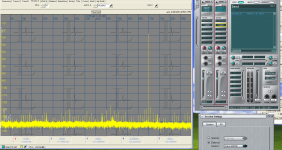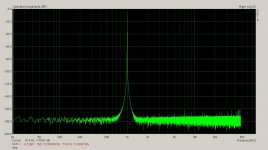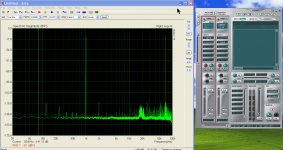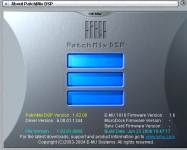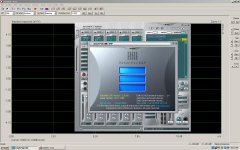You can let the USBStreamer synchronize to the Toslink input, but there are some problems:
1. You cannot really use it to "control" the I2S interface, because the timing of the synchronized clock drifts over several bit clocks.
2. You still need to set the sample rate in the PC application.
I gave up this method long ago, so I don't remember if I tested it at all sample rates. You can actually set it to e.g. 96 kHz sampling even if you input a 48 kHz audio stream on the Toslink input. It will still lock, but of course you would only get a valid output signal, not a valid input signal due to the sample rate mismatch.
I really cannot recommend using the Toslink interfaces to control the USBStreamer.
The Toslink channels may be used if you need 10 channels. Then the Toslinks could be used for the last 2 in and 2 out. But I still recommend to lock the MCLK as suggested previously.
1. You cannot really use it to "control" the I2S interface, because the timing of the synchronized clock drifts over several bit clocks.
2. You still need to set the sample rate in the PC application.
I gave up this method long ago, so I don't remember if I tested it at all sample rates. You can actually set it to e.g. 96 kHz sampling even if you input a 48 kHz audio stream on the Toslink input. It will still lock, but of course you would only get a valid output signal, not a valid input signal due to the sample rate mismatch.
I really cannot recommend using the Toslink interfaces to control the USBStreamer.
The Toslink channels may be used if you need 10 channels. Then the Toslinks could be used for the last 2 in and 2 out. But I still recommend to lock the MCLK as suggested previously.
I would be too. I wanted to be sure so here is a loopback done two ways. First on the XP system using the 1616M's digital I/O at 192. Second on the Win 7 system that currently has the 1212M installed digital I/O using ASIO at 192. I'm having trouble with Win 7 and getting the digital I/O working using the windows sound engine. it works fine on ASIO. XP's sound engine works fine both ways.
The cards are going to an AKM AKD4414 demo board and then to an AKD5394A demo board. The system is locked to the clock of the AKD5394A at 192K. If I tell the system to run with internal clocking the out of sync data causes a major dropout every 5 to 10 seconds. it took me a while to find the external sync option.
The Patchmix DSP control app is not easy. It has a jillion options and is cursed with overdone graphics. I'm starting to learn my way around. Its not for someone like me who is changing everything a lot. I'm living with it and I have a number of different sessions stored.
The cards are going to an AKM AKD4414 demo board and then to an AKD5394A demo board. The system is locked to the clock of the AKD5394A at 192K. If I tell the system to run with internal clocking the out of sync data causes a major dropout every 5 to 10 seconds. it took me a while to find the external sync option.
The Patchmix DSP control app is not easy. It has a jillion options and is cursed with overdone graphics. I'm starting to learn my way around. Its not for someone like me who is changing everything a lot. I'm living with it and I have a number of different sessions stored.
Attachments
I would be too. I wanted to be sure so here is a loopback done two ways. First on the XP system using the 1616M's digital I/O at 192. Second on the Win 7 system that currently has the 1212M installed digital I/O using ASIO at 192. I'm having trouble with Win 7 and getting the digital I/O working using the windows sound engine. it works fine on ASIO. XP's sound engine works fine both ways.
The cards are going to an AKM AKD4414 demo board and then to an AKD5394A demo board. The system is locked to the clock of the AKD5394A at 192K. If I tell the system to run with internal clocking the out of sync data causes a major dropout every 5 to 10 seconds. it took me a while to find the external sync option.
The Patchmix DSP control app is not easy. It has a jillion options and is cursed with overdone graphics. I'm starting to learn my way around. Its not for someone like me who is changing everything a lot. I'm living with it and I have a number of different sessions stored.
I confirmed the 96kHz max SPDIF on EMU's web site. Says so in the specs.
I did get the spdif working with the USBstreamer TOSlink input. The output from the 1212 spdif is AC. The input to the USBstreamer is 3.3V LVcmos. This presented a problem because the streamer input was only seeing the peaks of the spdif signal. I had to put a bias on the input to center the eye at mid logic level. It's going to require a differential receiver like the RS422 which seems to be the standard for digital audio.
I would be too. I wanted to be sure so here is a loopback done two ways. First on the XP system using the 1616M's digital I/O at 192. Second on the Win 7 system that currently has the 1212M installed digital I/O using ASIO at 192. I'm having trouble with Win 7 and getting the digital I/O working using the windows sound engine. it works fine on ASIO. XP's sound engine works fine both ways.
The cards are going to an AKM AKD4414 demo board and then to an AKD5394A demo board. The system is locked to the clock of the AKD5394A at 192K. If I tell the system to run with internal clocking the out of sync data causes a major dropout every 5 to 10 seconds. it took me a while to find the external sync option.
The Patchmix DSP control app is not easy. It has a jillion options and is cursed with overdone graphics. I'm starting to learn my way around. Its not for someone like me who is changing everything a lot. I'm living with it and I have a number of different sessions stored.
I know what you mean about the UI. It's not for the blind like me. They could have made it bigger.
I confirmed the 96kHz max SPDIF on EMU's web site. Says so in the specs.
I did get the spdif working with the USBstreamer TOSlink input. The output from the 1212 spdif is AC. The input to the USBstreamer is 3.3V LVcmos. This presented a problem because the streamer input was only seeing the peaks of the spdif signal. I had to put a bias on the input to center the eye at mid logic level. It's going to require a differential receiver like the RS422 which seems to be the standard for digital audio.
As far as the spec its clearly working at 192K or the 70 KHz line would not be there. I think EMU is a pretty disorganized operation and probably passing into history. The latest press release on their site is from 2010.
There are some Win 7 beta drivers I'll try next.
SPDIF and AES are both AC coupled (transformer preferably) and need a receiver of some sort. your biased input should work and the jitter may be high but the data should be OK.
If I switch to 192kHz the spdif output stops. Nothing on the scope.
Here is the 1212 looped back to the USBStreamer at 96kHz.
I have one instance of ARTA sending a sine to the 1212 and another instance of ARTA receiving the sine through the USBStreamer. No convertor in the loop.
Here is the 1212 looped back to the USBStreamer at 96kHz.
I have one instance of ARTA sending a sine to the 1212 and another instance of ARTA receiving the sine through the USBStreamer. No convertor in the loop.
Attachments
Digital to digital always looks so good. . .
Which OS? Do you know which driver revisions? ASIO or WDM? (Use ASIO where you can.) I have attached some of the sessions I'm using.
OS is XP pro. Always ASIO. Still can't get 192KHz. I'll try your sessions.
I wonder if there is a difference with vintage. The drivers are whatever the last posted on EMU's web Page.
I used to do warranty board swaps for EMU back when it was EMU. We where the only warranty depot in Canada. That says a lot by itself. Great company back then and so where the products. I was shocked when I heard they sold out to Creative. And I mean sold out in every sense of the phase. Been down hill ever since.
When I tried to load the 192kHz session the UI said I don't have enough hardware installed to load the session. Maybe that's why 192kHz doesn't work.
OK, I had to check so i swapped the 1212 back into the XP machine. I needed to reinstall the drivers (??) but that took quickly. XP on an SSD is pretty snappy. A few false starts with the wrong session (microdock settings don't work with the internal card) and I got it all working using WDM. Below is the loopback through the external ADC/DAC. Attached is the specific session I used. Versions are on the graphic. I could send the drivers to you but I just ndownloaded them so it should not be necessary.
All this said I would be using a Juli@ card for the work you are doing. Lots fewer places to get lost and only a small degradation in audio quality with the on board DAC/ADC. But you already have this one.
All this said I would be using a Juli@ card for the work you are doing. Lots fewer places to get lost and only a small degradation in audio quality with the on board DAC/ADC. But you already have this one.
Attachments
OK, I had to check so i swapped the 1212 back into the XP machine. I needed to reinstall the drivers (??) but that took quickly. XP on an SSD is pretty snappy. A few false starts with the wrong session (microdock settings don't work with the internal card) and I got it all working using WDM. Below is the loopback through the external ADC/DAC. Attached is the specific session I used. Versions are on the graphic. I could send the drivers to you but I just ndownloaded them so it should not be necessary.
All this said I would be using a Juli@ card for the work you are doing. Lots fewer places to get lost and only a small degradation in audio quality with the on board DAC/ADC. But you already have this one.
Just get the same message. insufficient hardware to run the session.
I'll get a Juli@ card if I can find one at a decent price.
Let me check. I may want to trade a Juli@ for the 1212m.
We are way off the QA400 topic but I'll be back to it soon.
We are way off the QA400 topic but I'll be back to it soon.
I checked and you have the first gen EMU 1212M. Its not compatible with the microdock. Possibly why its not working at 192 properly. They really revised the card and did not change the name. The way you tell them apart is that the old one has a firewire port. The new one does not. I'll still check on supply of Juli@'s for you.
I checked and you have the first gen EMU 1212M. Its not compatible with the microdock. Possibly why its not working at 192 properly. They really revised the card and did not change the name. The way you tell them apart is that the old one has a firewire port. The new one does not. I'll still check on supply of Juli@'s for you.
I See. Well here the driver.
Attachments
Let me check. I may want to trade a Juli@ for the 1212m.
We are way off the QA400 topic but I'll be back to it soon.
Well we have to keep the folks entertained in between QA updates.
I checked and you have the first gen EMU 1212M. Its not compatible with the microdock. Possibly why its not working at 192 properly. They really revised the card and did not change the name. The way you tell them apart is that the old one has a firewire port. The new one does not. I'll still check on supply of Juli@'s for you.
Yes it does have the 1394 port.
Technically it is Dick's card. I would have ask about trading it.
I'm really confused. You have much newer firmware on the 1010. I don't see what is on the card that is programmable? I'm not sure how to get current, or if I want to. I installed first from the CD shipped and then updated. When I did not do the first install from the CD it was really buggy.
- Home
- Design & Build
- Equipment & Tools
- QuantAsylum QA400 and QA401
